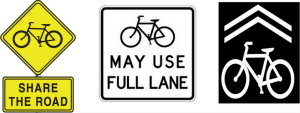 An article in the peer-reviewed, open access journal, PLOS ONE, reports the results of a study examining how well three U.S. traffic control devices communicate that bicyclists are permitted in the center of the travel lane and do not have to "get out of the way" to allow motorists to pass without changing lanes. It analyzed the: "Bicycles May Use Full Lane" signage, "Share the Road" signage, and Shared Lane Markings, or "sharrows," painted on the pavement. The study included a web-based survey that recruited responses via Twitter and each traffic control device was compared to an unsigned roadway. In addition, survey respondents were asked whether it was safe for a bicyclist to occupy the center of the travel lane.
An article in the peer-reviewed, open access journal, PLOS ONE, reports the results of a study examining how well three U.S. traffic control devices communicate that bicyclists are permitted in the center of the travel lane and do not have to "get out of the way" to allow motorists to pass without changing lanes. It analyzed the: "Bicycles May Use Full Lane" signage, "Share the Road" signage, and Shared Lane Markings, or "sharrows," painted on the pavement. The study included a web-based survey that recruited responses via Twitter and each traffic control device was compared to an unsigned roadway. In addition, survey respondents were asked whether it was safe for a bicyclist to occupy the center of the travel lane.
"Bicycles May Use Full Lane" signage was the most consistently comprehended device for communicating the message that bicyclists may occupy the travel lane and also increased perceptions of safety. "Share the Road" signage did not increase comprehension or perceptions of safety. Shared Lane Markings fell somewhere between. "Bicycles May Use Full Lane" signage showed notable increases in comprehension among novice bicyclists and private motor vehicle commuters (both critical target audiences for efforts to promote bicycling in the U.S.). Although limited in scope, the survey results are indicative and suggest that transportation agencies consider replacing "Share the Road" with "Bicycles May Use Full Lane" signage, possibly combined with Shared Lane Markings, if the intent is to increase awareness of roadway rights and responsibilities.
Ride Illinois has also produced a briefing paper focused on this issue. targeted to the state of Illinois.